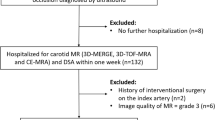Abstract
Magnetic resonance angiography (MRA) is increasingly used as a non-invasive method to assess carotid arteries. Contrast-enhanced MRA (CE-MRA) has benefited from rapid technological developments, including specific hardware and pulse sequence design. In the evaluation of stenoses of the extracranial internal carotid artery (ICA), CE-MRA using “first generation” CE-MRA gadolinium (Gd)-based chelates can be a substitute for conventional digital subtraction angiography (DSA), although CE-MRA tends to overestimate the degree of stenosis. Studies describing the use of high-relaxivity contrast agents like gadobenate dimeglumine (Gd- BOPTA) reveal that this agent is safe and well tolerated for CE-MRA. The use of Gd-BOPTA shows significantly better quantitative and qualitative performance than carotid CE-MRA using first generation Gd-based chelates. In fact, CE-MRA with Gd-BOTPA provides information comparable to that attainable with rotational DSA. In conclusion, high-relaxivity contrast agents combined with dedicated MRA software appear to be optimal for achieving high-quality evaluation of the carotid arteries.
Similar content being viewed by others
Author information
Authors and Affiliations
Corresponding author
Rights and permissions
About this article
Cite this article
Thurnher, S.A. MRA of the carotid arteries. Eur Radiol Suppl 15 (Suppl 5), e11–e16 (2005). https://doi.org/10.1007/s10406-005-0161-2
Issue Date:
DOI: https://doi.org/10.1007/s10406-005-0161-2




